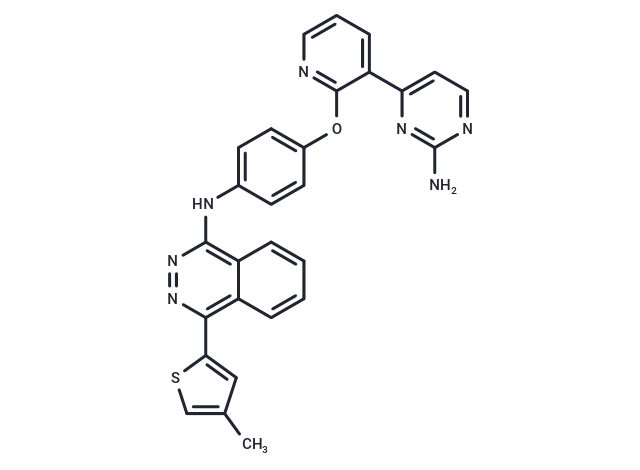Shopping Cart
Remove All Your shopping cart is currently empty
Your shopping cart is currently empty
AMG 900 is a potent and highly selective pan-Aurora kinases inhibitor for Aurora A/B/C with IC50 values of 5 nM, 4 nM, and 1 nM, respectively. It exhibits over 10-fold selectivity for Aurora kinases compared to p38α, Tyk2, JNK2, Met, and Tie2. [Phase 1].

| Pack Size | Price | USA Warehouse | Global Warehouse | Quantity |
|---|---|---|---|---|
| 1 mg | $44 | In Stock | In Stock | |
| 5 mg | $98 | In Stock | In Stock | |
| 10 mg | $169 | In Stock | In Stock | |
| 25 mg | $318 | In Stock | In Stock | |
| 50 mg | $492 | In Stock | In Stock | |
| 100 mg | $717 | In Stock | In Stock | |
| 500 mg | $1,490 | - | In Stock | |
| 1 mL x 10 mM (in DMSO) | $107 | In Stock | In Stock |
| Description | AMG 900 is a potent and highly selective pan-Aurora kinases inhibitor for Aurora A/B/C with IC50 values of 5 nM, 4 nM, and 1 nM, respectively. It exhibits over 10-fold selectivity for Aurora kinases compared to p38α, Tyk2, JNK2, Met, and Tie2. [Phase 1]. |
| Targets&IC50 | Aurora B:4 nM, Aurora A:5 nM, Aurora C:1 nM |
| In vitro | AMG 900 is a novel class of ATP-competitive phthalazinamine small molecule inhibitors of aurora kinases. In HeLa cells, AMG 900 inhibits autophosphorylation of aurora-A and -B as well as phosphorylation of histone H3 on Ser, a proximal substrate of aurora-B. The predominant cellular response of tumor cells to AMG 900 treatment is aborted cell division without a prolonged mitotic arrest, which ultimately results in cell death. AMG 900 inhibits the proliferation of 26 tumor cell lines, including cell lines resistant to the antimitotic drug paclitaxel and to other aurora kinase inhibitors (AZD1152, MK-0457, and PHA-739358), at low nanomolar concentrations (about 2- 3 nM). Furthermore, AMG 900 is active in an AZD1152-resistant HCT116 variant cell line that harbors an aurora-B mutation (W221L). [1] |
| In vivo | Oral administration of AMG 900 blocks the phosphorylation of histone H3 in a dose-dependent manner and significantly inhibited the growth of HCT116 tumor xenografts. AMG 900 is broadly active in multiple xenograft models, including 3 multidrugresistant xenograft models, representing 5 tumor types. [1] AMG 900 exhibits a low-to-moderate clearance and a small volume of distribution. Its terminal elimination half-life ranged from 0.6 to 2.4 hours. AMG 900 is well-absorbed in fasted animals with an oral bioavailability of 31% to 107%. Food intake has an effect on rate (rats) or extent (dogs) of AMG 900 oral absorption. The clearance and volume of distribution at steady state in humans are predicted to be 27.3 mL/h/kg and 93.9 mL/kg, respectively. AMG 900 exhibits acceptable PK properties in preclinical species and is predicted to have low clearance in humans. [2] |
| Kinase Assay | Enzyme kinase assays: Recombinant GST- or His-tagged aurora-A (TPX2), and aurora-B proteins are expressed using a baculovirus system and purified by affinity chromatography. AMG 900 activity is assessed using a standardized homogenous time-resolved fluorescence (HTRF) assay. Enzyme assays for 24 other kinases (aurora-C, p38α, TYK2, JNK2, JAK3, c-Met, VEGFR2, p38β, TIE-2, ABL (T315I), ERK1, BTK, JNK3, CDK5, PKAα, JNK1, p70S6K, PKBα, MSK1, LCK, SRC, IGFR, JAK2, and c-KIT) are done internally in a similar manner. Concentrations of enzyme, peptide substrate, and ATP in the reaction are optimized depending on the specific activity of the kinase and measured Km values for their corresponding substrates. AMG 900 is evaluated in a kinome competition binding assay (n = 353 unique kinases) by Ambit Biosciences. AMG 900 is initially screened at a single concentration of 1000 nM, and quantitative binding constants (Kd) are determined for each positive hit (< 20 percentage of control). |
| Cell Research | Tumor cells are treated with AMG 900 for 48 hours, washed twice with complete media, and cells are replated at a density of 5000 cells per well in drug-free complete media. Cells are grown until the DMSO control wells are confluent. Cells are stained with crystal violet dye, washed with distilled water, and imaged using a digital scanner.(Only for Reference) |
| Synonyms | AMG-900, AMG900 |
| Molecular Weight | 503.58 |
| Formula | C28H21N7OS |
| Cas No. | 945595-80-2 |
| Smiles | Cc1csc(c1)-c1nnc(Nc2ccc(Oc3ncccc3-c3ccnc(N)n3)cc2)c2ccccc12 |
| Relative Density. | 1.380 g/cm3 |
| Storage | Powder: -20°C for 3 years | In solvent: -80°C for 1 year | Shipping with blue ice/Shipping at ambient temperature. | |||||||||||||||||||||||||||||||||||
| Solubility Information | Ethanol: < 1 mg/mL (insoluble or slightly soluble) H2O: < 1 mg/mL (insoluble or slightly soluble) DMSO: 93 mg/mL (184.68 mM), Sonication is recommended. | |||||||||||||||||||||||||||||||||||
| In Vivo Formulation | 10% DMSO+40% PEG300+5% Tween 80+45% Saline: 5 mg/mL (9.93 mM), Sonication is recommended. Please add the solvents sequentially, clarifying the solution as much as possible before adding the next one. Dissolve by heating and/or sonication if necessary. Working solution is recommended to be prepared and used immediately. The formulation provided above is for reference purposes only. In vivo formulations may vary and should be modified based on specific experimental conditions. | |||||||||||||||||||||||||||||||||||
Solution Preparation Table | ||||||||||||||||||||||||||||||||||||
DMSO
| ||||||||||||||||||||||||||||||||||||
| Size | Quantity | Unit Price | Amount | Operation |
|---|

Copyright © 2015-2025 TargetMol Chemicals Inc. All Rights Reserved.